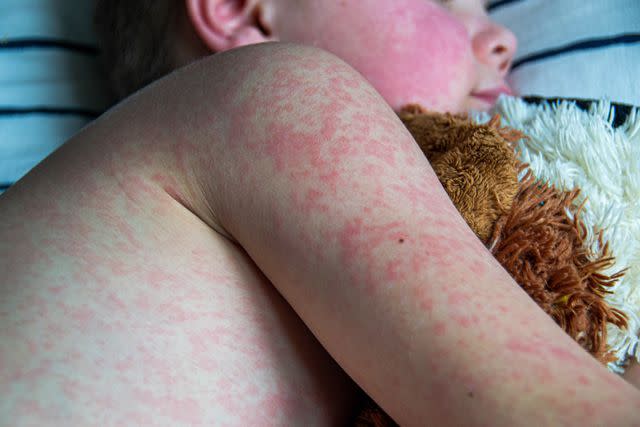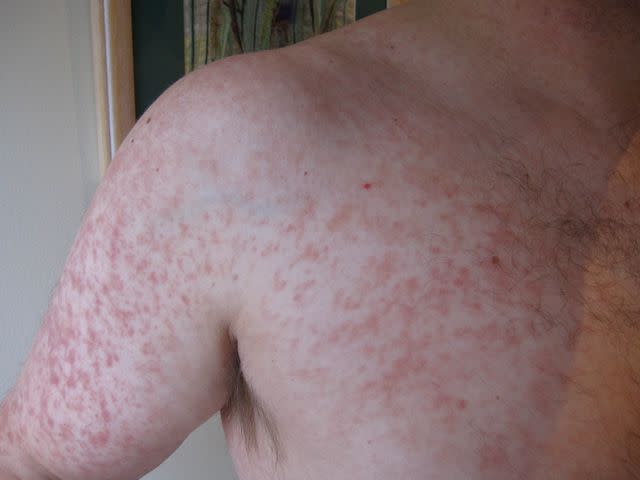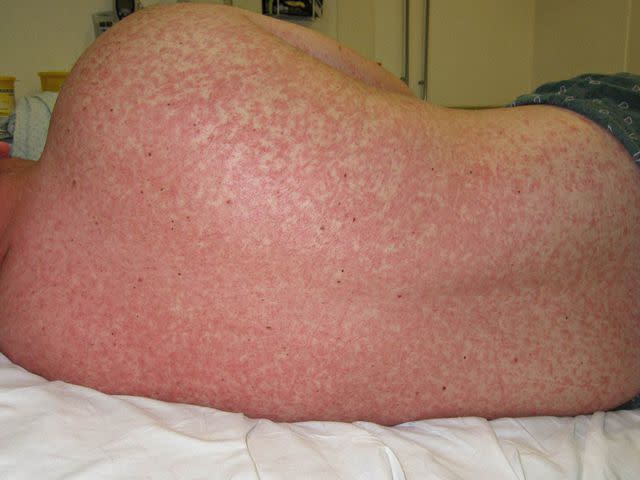What Does a Measles Rash Look Like?
Medically reviewed by Michael Menna, DO
Knowing the early signs of measles and its rash can help you recognize the illness as early as possible. Prompt treatment can help reduce the risk of severe problems.
This article can help you know what a measles rash looks like so you can contact your healthcare provider as early as possible for the best outcomes.

Povorozniuk Liudmyla / Getty Images
Learn More: What Happens If You Contract Measles and How Likely Is It?
What Are the First Signs of Measles?
The first signs of measles usually appear 10 to 14 days after exposure to the virus. The incubation period is between your contact with an infected person and the onset of symptoms.
The early symptoms of measles typically occur about one to four days before the characteristic rash breaks out. These symptoms include:
High fever (may spike to more than 104 degrees Fahrenheit)
Runny nose
Cough
Conjunctivitis (pink eye) or red, watery eyes
Koplik Spots
Koplik spots are symptoms that are disease-specific to measles. These spots appear as yellow raised spots and bluish-white specks. They are about 2 millimeters (mm) to 3 mm, often on a reddened background. These raised spots develop on the inside of your cheeks near your molars.
Koplik spots typically occur a few days before the measles rash. The spots are considered a key indicator for the early diagnosis of measles. They are present in about 80% of measles cases.
The Measles Rash

Reproduced with permission from © DermNet dermnetnz.org 2023
The measles rash is the most prominent symptom of the disease. It usually appears about three to five days after symptoms start.
While the rash is a common symptom of the disease, the following types of people may not have the rash:
People who are immunocompromised
Young infants who still have maternal antibodies
People who receive immunoglobulin before the rash develops
Learn More: Symptoms of Measles
What Does a Measles Rash Look Like?

Reproduced with permission from © DermNet dermnetnz.org 2023
The measles rash is distinctive and spreads over three days. It usually begins on your face, forehead, and hairline with lesions that are distinctive to the disease.
As it grows, the spots spread downward into a neck rash. It continues to your torso and then to your hands and feet. The spots typically have the following characteristics:
Deep, flat, red or reddish brown spots that are distinct but create a blotchy appearance
Small raised bumps on top of the flat red spots
Gradual combination of lesions as the disease spreads, giving the appearance of one big rash
Learn More: Common Skin Rashes in Children
How Long Does It Take a Measles Rash to Heal?
While everyone's experience can differ, a measles rash usually begins to heal after about three to seven days of its onset. It is usually accompanied by a decrease in fever and improvement in general symptoms.
Measles Complications
Measles complications can affect anyone. In the United States, about 1 in 5 unvaccinated people who get measles becomes hospitalized for some type of complication. The following groups are most vulnerable to measles complications:
Children under 5 years old
Adults over 20 years old
People with immunocompromised immune systems due to issues such as leukemia, HIV infection, or chemotherapy
Pregnant people
Common complications from measles can include the following:
Acute otitis media (ear infections)
Ear infections are the most common complication of measles in children, affecting 7% to 9% of infected children.
Diarrhea
Diarrhea is a common complication of measles during the acute phase of measles infection. This phase includes the one week before the onset of the disease until four weeks after the appearance of the measles rash. It can lead to dehydration.
Pregnancy complications
In pregnant people who have not received the measles vaccine, measles is linked with premature birth, miscarriage, stillbirth, and low birth weight babies.
Pneumonia
Pneumonia affects about 5% of children with measles. This complication is the most common cause of death from measles in children.
Encephalitis
Encephalitis (swelling of the brain) affects about one out of every 1,000 children who get measles. This condition can cause convulsions. Its effect can result in hearing loss or intellectual disability in the affected child.
Vision Problems and Blindness
Measles can cause the following types of vision problems:
Keratitis: Keratitis is an infection of the cornea, the window of the eye.
Corneal ulcers and scarring: Keratitis can worsen and become a corneal ulcer (open sores on the front of the eye that appear as a white dot on your cornea).
Retinopathy: Though rare, measles can cause retinopathy, damage to the retina (the layer of cells in the back of your eye that convert light into electrical impulses that go to your brain)
Optic neuritis: Optic neuritis is an inflammation of the optic nerve, the large cable that sends signals from the back of the eye to your brain.
Blindness: Measles is a leading cause of childhood blindness, especially in countries where children deal with malnutrition and vitamin A deficiency. Blindness often occurs as a result of corneal scarring and keratitis.
Subacute Sclerosing Panencephalitis (SSPE)
SSPE is a rare but deadly complication of the measles virus. It occurs about seven to 10 years after the measles infection despite the appearance of a full recovery from the disease.
SSPE is a progressive, disabling, and deadly brain disorder that causes symptoms such as memory loss, uncontrollable movements, and seizures. This progressive disease causes blindness, the inability to walk, and the eventual deterioration to a persistent vegetative state that leads to death.
Death
Measles is fatal for one to three of every 1,000 children who become infected with the disease. Death typically occurs due to respiratory and neurologic complications.
How Long Does a Measles Rash Last?
A measles rash usually starts to improve within one to two days after the eruption of the rash peaks. Healing begins as the rash fades into light brown pigmentation in the sequence of its eruption.
These changes in skin color are usually gone after one to two weeks of shedding of the epidermis in the form of tiny fine scales (branny desquamation).
Other Infections With Rashes
While the measles rash has a distinctive appearance, it can sometimes be hard to distinguish it from other infections with rashes. Some other infections that can present with symptoms and a rash similar to measles include:
German Measles (Rubella)
German measles (rubella) is a contagious disease caused by a virus different from the virus that causes measles. A rubella rash begins with a mild rash with pink or light red spots. It first appears on your face and spreads to the rest of your body, lasting about three days.
Up to 50% of people infected with German measles are asymptomatic. People who get sick from German measles have the following problems one to five days before the rash appears:
Mild illness
Sore throat
Headache
Mild conjunctivitis
Swollen and enlarged lymph nodes
Roseola (Sixth Disease)
Roseola is a common viral infection that most often occurs in children between 6 months and 4 years. It is caused by the human herpesvirus 6 or 7.
Roseola begins with a high fever (101 degrees Fahrenheit to 105 degrees Fahrenheit). The illness ends with a rose-colored rash that appears as rose-colored, blanchable red bumps. The bumps are between 1 millimeter and 5 millimeters and are often surrounded by a pale halo.
The roseola rash starts on the trunk and spreads to the neck, buttocks, extremities, and face. It usually lasts for one to two days. The following symptoms may occur before the rash:
Diarrhea
Vomiting
Sore throat
Runny nose
Red Eyes
Nagayama spots (red papules found on the soft palate and uvula)
Enlarged lymph nodes on the neck
Hand, Foot, and Mouth Disease
Hand, foot, and mouth disease (HFMD) is a contagious disease caused by viruses in the enterovirus family, including Coxsackievirus. While most common in children younger than 5 years old, it can also affect teens and adults.
Symptoms of HFMD occur three to seven days after exposure to the virus. The disease is characterized by the following symptoms:
Painful mouth sores that start as red or discolored bumps then become blisters
Itchy or bumpy rash with small flat or slightly raised blisters on the hands and/or soles of your feet or other body parts
Fever
Sore throat caused by ulcers on your throat, tonsils, mouth, and tongue
Headache
Loss of appetite
Chickenpox
Chickenpox is a highly contagious disease caused by the varicella-zoster virus. Early symptoms can include a headache, sore throat, or stomachache. These symptoms can last a few days, and the fever is between 101 degrees to 102 degrees Fahrenheit.
The chickenpox rash typically appears within 10 to 21 days after exposure to an infected person. The rash involves 250 to 500 itchy, fluid-filled blisters that erupt in the following pattern:
The first eruptions occur on the face, mid-torso, or scalp.
After a day or two, the first blisters turn cloudy and burst as new blisters form in the mouth, vagina, and on the eyelids.
After the blisters burst, they leave open sores that crust over to form dry, brown scabs.
All of the blisters typically become scabs within a week.
Fifth Disease
Fifth disease (erythema infectiosum) is a highly contagious viral rash caused by human parvovirus B19. The peak age for this disease is between 5 and 15.
Symptoms of fifth disease typically progress in the following pattern:
The first symptom is a distinct rash that makes a child's cheeks bright red, similar to the appearance of being slapped.
A second lighter red and blotchy rash appears a few days later and spreads to the trunk, arms, and legs in a few days.
In its final stages, the rash becomes lacy and net-like in appearance. It lasts about one to three weeks.
Other symptoms of fifth disease can include:
Fever
Headache
Cough and/or sore throat
Painful or swollen joints
Scarlet Fever
Scarlet fever is caused by a bacteria called group A Streptococcus (group A strep). This bacteria also causes strep throat. The rash occurs when the bacteria release a toxin that triggers this symptom.
Scarlet fever includes symptoms that affect your throat, tongue, and neck in the following ways:
Whitish coating on your tongue
Red and bumpy tongue (strawberry tongue)
Red and swollen tonsils
White patches or streaks of pus on your tonsils
Petechiae (small, pinpoint reddish-brown spots on the roof of your mouth)
Swollen lymph nodes in the front of your neck
A rash with the following features typically appears within a day or two after other symptoms. It can also appear before the illness or up to seven days after other symptoms. A scarlet fever rash can involve:
A rough red rash that begins as small, flat blotches that changes into fine bumps on rough skin
Brighter red skin in the creases of your underarm, elbow, and groin
A pale area around your mouth
Spread from the neck, underarms, and groin to the rest of your body
Skin peeling as your rash fades
Learn More: A Guide to Viral Rashes in Adults and Children
When to Contact a Healthcare Provider?
Contact your healthcare provider immediately if you or your child may have measles or have been around someone who has measles. Getting a diagnosis as early as possible is key to preventing complications from measles.
If you or your child have not been vaccinated, a measles vaccine may help prevent disease if you receive it within 72 hours of first exposure. Immune globulin (a blood product containing measles antibodies) may prevent or lessen the severity of measles if you receive it within six days of first exposure.
Contacting a healthcare provider about a measles rash is especially important if any of the following circumstances exist:
Your child is an infant.
You or your child are taking medications that suppress your immune system.
You or your child have tuberculosis, cancer, or a disease that affects your immune system.
You or your child hasn't received two doses of the measles vaccine.
You are pregnant.
Summary
A measles rash is a common symptom of the measles virus. Though quite rare, measles poses serious health risks for anyone who is not vaccinated.
The disease can cause severe results, including death, for children under the age of 5. Adults over age 20, pregnant women, and people with compromised immune systems also have a high risk of complications.
Anyone with a fever and unexplained rash should be examined by a healthcare provider. Knowing the signs of a measles rash can help you get the right treatment. An early diagnosis can help you or your child get treatment in time to reduce symptoms and the risk of severe problems.
Read the original article on Verywell Health.

